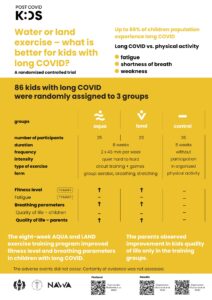Subtitle: Discover which type of exercise—water-based or land-based—better helps children with long COVID
Key words: child; long COVID; SARS-CoV-2, exercise
What is long COVID in children?
Long COVID is when children continue to feel unwell weeks or even months after recovering from COVID-19. There is no single definition, but experts agree that it includes symptoms that start or continue long after the infection has gone.
Children with long COVID often report symptoms such as tiredness, shortness of breath, difficulty exercising, muscle and joint pain, headaches, trouble sleeping, and a racing heartbeat. Although studies report different numbers, most suggest that about 10% to 20% of children experience symptoms in the first six months after infection (1).
Why is treatment for long COVID in children important?
Long COVID can affect many areas of a child’s life. It can make it hard for them to attend school, enjoy physical activity, and take part in hobbies and social activities. These challenges can also impact their emotional well-being. Unfortunately, there is very little research on what kinds of treatments or programs help children recover and therefore, formed the basis of our study’s rationale. We wanted to see if structured exercise programs—either in water or on land—could help improve fitness, breathing, and quality of life in children with long COVID.
Why we chose water and land exercise programs
Rehabilitation through physical activity is currently one of the most promising ways to help with long COVID symptoms. We designed two fun and supportive programs that followed best practices for helping children (2). The water-based programs are known to improve fitness, breathing, and well-being in children with breathing problems. The land-based program is enjoyable for children and often leads to good attendance and effort, especially for those who have had asthma or similar conditions.
How did we go about the study?
We ran a randomized controlled trial, which is a type of study that helps us compare treatments in a fair and unbiased way. The study involved children aged 10 to 12 who had long COVID symptoms. Children were randomly placed in one of three groups: a water-based exercise group (AQUA), a land-based exercise group (LAND), or a control group that did not receive any special exercise program. The AQUA and LAND programs ran for 8 weeks, with sessions twice per week.
We measured changes in exercise capacity (using a treadmill test), fatigue (with a questionnaire), lung function (with breathing tests), and quality of life (reported by both children and their parents).
What did we find?
Eighty-six children joined the study, and 74 completed the program and the follow-up assessments. Both the AQUA and LAND groups showed improvements in their ability to exercise. These improvements were statistically significant in both the AQUA (p = 0.001) and LAND (p = 0.004) groups.
Lung function, measured by how much air the children could blow out in one second, also improved in both exercise groups compared to the control group. Parents of children in the LAND group reported a clear improvement in their child’s quality of life after the program.
Conclusion – What can you take away?
A structured 8-week exercise program—whether in water or on land—can help children with long COVID feel stronger and breathe better.
Parents also noticed a positive difference in their children’s well-being, especially after the land-based program.

Authors:
Anna Ogonowska-Slodownik 1, Marta Kinga Labeck 1 , Agnieszka Maciejewska-Skrendo 2,3 ,
Renae J. McNamara 4,5,6, Katarzyna Kaczmarczyk 1 , Michał Starczewski 1 , Jan Gajewski 1,
Natalia Morgulec-Adamowicz 1
1 Faculty of Rehabilitation, Jozef Pilsudski University of Physical Education in Warsaw
2 Faculty of Physical Culture, Gdansk University of Physical Education and Sport, Gdansk, Poland;
3 Institute of Physical Culture Sciences, University of Szczecin, Szczecin, Poland
4 Physiotherapy, Prince of Wales Hospital, Sydney, Australia;
5 Faculty of Medicine and Health, Sydney School of Health Sciences, The University of Sydney,
Sydney, Australia
6 Woolcock Institute of Medical Research, Sydney, Australia
Competing interests: none
Funding: National Agency for Academic Exchange, BPN/GIN/2021/1/00071
References
- Rao S, Gross RS, Mohandas S, et al. Postacute Sequelae of SARS-CoV-2 in Children. Pediatrics. 2024;153(3):e2023062570. doi:10.1542/peds.2023-062570.
- Ogonowska-Slodownik A, Labecka MK, Kaczmarczyk K, McNamara RJ, Starczewski M, Gajewski J, Maciejewska-Skrendo A, Morgulec-Adamowicz N. Water-Based and Land-Based Exercise for Children with Post-COVID-19 Condition (postCOVIDkids)—Protocol for a Randomized Controlled Trial. Int J Enviro Res Pub Health. 2022; 19(21):14476. doi:10.3390/ijerph192114476.
- Ogonowska-Slodownik A, Labecka MK, Maciejewska-Skrendo A, et al. Effect of Water-Based vs. Land-Based Exercise Intervention (postCOVIDkids) on Exercise Capacity, Fatigue, and Quality of Life in Children with Post COVID-19 Condition: A Randomized Controlled Trial. J Clin Med. 2023;12(19):6244. Published 2023 Sep 28. doi:10.3390/jcm12196244.
- Ogonowska-Slodownik A, Labecka MK, Maciejewska-Skrendo A, Morgulec-Adamowicz N, Starczewski M, Gajewski J, McNamara RJ, Kaczmarczyk K. Effect of water- and land-based exercise on lung function in children with post COVID-19 condition: secondary results from a randomized controlled trial. ERJ Open Res. 2025. doi: 10.1183/23120541.00838-2024.